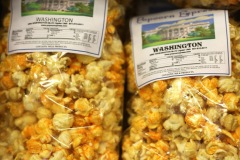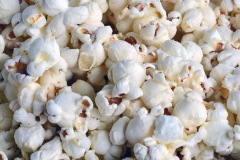History Of Popcorn
There is some debate about the ancient history of popcorn, but most scholars can agree on a few things. Popcorn seems to have originated in the Americas, after years of crossbreeding various types of wild grasses. Some ancient grains of popcorn, discovered in Peru, have been so well preserved that it is believed they could be popped and eaten today! European settlers in the Americas were introduced to popcorn by the indigenous people, who roasted the corn cobs over the fire to produce the fluffy snack.

Popcorn really started to catch on as a snack in the late 1800s. It has remained a family favorite since then, especially gaining popularity during the Great Depression. At 5 to 10 cents a bag, it was one snack that struggling families could afford. While many industries suffered during the Depression, the popcorn business thrived—Orville Redenbacher started selling his famous popcorn at this time. During World War II, there was another resurgence as sugar shortages reduced candy production, and popcorn was enjoyed as a healthier alternative.
How does popcorn pop?
So what happens when a popcorn kernel pops? Well, the kernels have a small amount of moisture inside, as well as a starchy substance. Of course, they have a hard shell on the outside, called the hull. When popcorn is heated, the moisture inside heats up as well, turning into a steam and building up pressure inside the hull. The starch inside the kernel starts to gelatinize and soften. When the breaking point of the hull is reached (approximately 135 psi and 356°), the kernel explodes. At the sudden release of pressure, the rushing steam causes the gelatinized starch to form a foamy structure, which becomes the crispy, airy snack we eat!
The amount of moisture in the kernel, as well as the heating process, is very important. Too much moisture leads to chewy pieces, while too little moisture ensures that the kernel won’t produce enough steam to pop. If the popcorn is heated too slowly, the steam can leak out of the tip of the kernel and never reach enough pressure to pop at all. If heated too quickly, the hull explodes before the starch can fully gelatinize, resulting in partially popped kernels.
A popular YouTube channel called “The Slo Mo Guys” has created a video that shows popcorn popping in slow motion. Even at a “regular” slow motion speed, the explosion looks almost instantaneous, so they slowed down to 10,000 frames per second to capture a truly mesmerizing experience.
A tasty treat
Popcorn is traditionally eaten in movie theatres, covered in butter and salt. In recent years, more and more ways to eat popcorn have popped up. Kettle corn (popcorn mixed with a sugar and caramel glaze and popped in a kettle) was first introduced in the late 1700s, but fell out of style until its comeback during the 21st century. In the UK, popcorn is sometimes served with a toffee or caramel covering. In Peru, they sweeten popcorn with small candy pellets and sweetened condensed milk. The topping of choice in Mexico is jalapeño juice or hot sauce. Orville Redenbacher recently released a brand of cheese covered popcorn. Chocolate-drizzled popcorn is commonly referred to as “zebra corn.” Gourmet popcorn snacks offer variety of flavored popcorn, ranging from cinnamon to cranberry to almond to sour green apple. The “neutral” flavor of popcorn makes it the perfect blank canvas.
Air-popped popcorn in its most basic form is naturally high in dietary fiber and antioxidants. It’s also low in calories and fat, and free from sugar and sodium. By itself, it’s a healthy alternative for people with dietary restrictions, or those who want a healthy crunch without the added preservatives and fats. However, most people add salt and butter at the very least, sometimes in extremely ill-balanced proportions, making it difficult to justify the “healthy” benefits.
Did you know?
- Strings of popcorn – sometimes interspersed with cranberries or other pops of color – are often used as Christmas decorations in North America.
- In the late 80s and early 90s, some shipping companies experimented with popcorn as a natural, biodegradable packing material. However, the drawbacks for using popcorn outweighed the benefits: it attracted pests (insects, rodents, etc), it was more flammable than its plastic counterparts, it was practically useless (and perhaps damaging) when it got wet, and it contained small amounts of oil which could damage the materials being shipped.
- The world’s largest popcorn ball was unveiled in 2013 at the Indiana State Fair. The ball weighed a whopping 6,510 pounds, was approximately 8 feet in diameter, and had a circumference of 24 feet, 9 inches.
- The folklore of some Native American tribes told of a tiny spirit who lived within each kernel. When the spirit’s house was heated, he became upset and shook his house in anger. When the heat and anger became too much, he burst out of the house and exploded in a tiny puff of steam.















“Thanks for existing!!!! I haven’t had popcorn in so long and the salt & vinegar popcorn won my heart today!!!!”